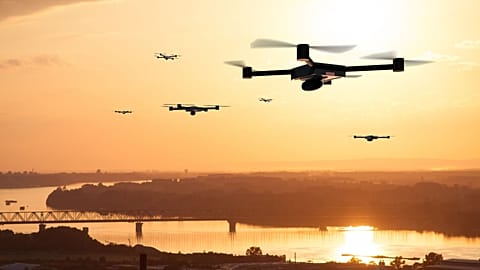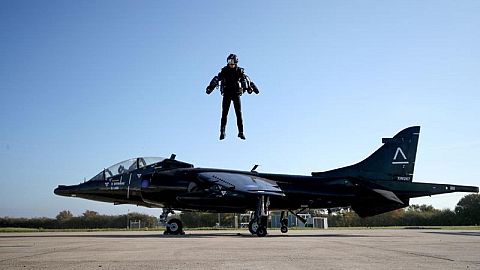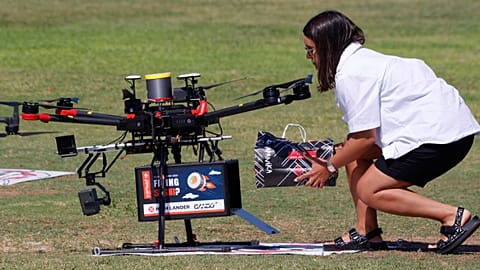An autonomous drone system in Sweden could reach cardiac arrest patients with defibrillators faster than emergency services.
When an alarm sounds at the Everdrone control room on the outskirts of Gothenburg, it means there's a medical emergency and its remote pilots should prepare to send an automated drone buzzing through the skies.
Swedish drone developer Everdrone has been collaborating with researchers at Stockholm's Karolinska Institute and the country's emergency dispatch organisation since 2019, exploring the use of drones to deliver automated external defibrillators (AEDs) to cardiac arrest patients, wherever they are.
"An autonomous system that can start instantly and has no issues with traffic will be much faster on site than an ambulance," said Everdrone founder and CTO Maciek Drejak.
"You still need an ambulance to take care of the patient, but if we can deliver the AED only a few minutes earlier, the gain is very large. The probability of surviving drops by approximately 10 per cent points per-minute, so every minute counts, every second counts, actually".
Traditionally low survival rates
Karolinska Institute associate professor Andreas Claesson says Sweden's emergency medical services receive reports of about 6,000 cardiac arrests a year; only around ten per cent of those patients survive.
About 70 per cent of out-of-hospital cardiac arrests occur in private homes without a defibrillator nearby, he says.
"We know that if it's possible to use an AED within the first three, five minutes, about 50 per cent of all patients may survive," said Claesson.
"So, we need to find novel methods in order to deliver AEDs during the first minutes".
The process begins like any other emergency; calls to Sweden's emergency 112 number are patched through to one of SOS Alarm's dispatch centres.
About 3.4 million calls are received annually.
How it works
If call handlers suspect a cardiac arrest and the patient is located in the trial area, a drone is dispatched, along with more traditional emergency services.
Mattias Regnell, head of innovation at SOS Alarm, says the drone system is electronically integrated with the emergency dispatch system.
"When they put that pin on the map, the system automatically knows that within this area, a drone needs to be dispatched," he explained.
During a study that began in February 2020, a total of 14 suspected cardiac arrest cases were eligible for drone delivery. Of those, drones were dispatched to 12 and AEDs were delivered to all but one.
"People are willing to help, and if we just can refine the system to aid our call takers, to having bystanders use the AED often, then we will see an increase in cases," said Regnell.
In most cases during the four-month study, the automated drone arrived at the emergency site on average about two minutes earlier than the ambulance, but those behind the project believe this can grow to three or four minutes earlier with certain refinements.
Patrik Segerfelt, head of a participating dispatch centre in western Gothenburg, says even when the AED wasn't used, it brought comfort to people on the scene as it told them help was on the way.
"Someone said it was comforting to know, even if in those cases [where] it didn't do any good other than comfort the people on the scene, because it was first," he said.
"First before the fire and rescue and the ambulance and the police. Then they knew that we at the triage centre, we knew where they were".
Pilot’s first successes
Last December, the project had its first true success, when an automated drone played a part in saving the life of a 71-year-old man in the Swedish city of Trollhattan, about 75 km north of Gothenburg.
Dr. Mustafa Ali was on his way to work when he spotted the man collapsed on his driveway. He quickly diagnosed cardiac arrest and called the emergency services.
"After about one, two minutes. I think (I heard) something in the air, but it's not like a helicopter, so I looked up and there is a drone," recalled Ali.
"First, I thought, there's somebody filming here, but at the same time [someone] from the alarm centre said: 'Here is your defibrillator, so just pick it up.' Okay!"
Everdrone says the time between the alarm being raised and AED delivery was just over three minutes.
Ali used the drone's defibrillator and continued defibrillation in the ambulance. The patient survived.
When delivering the AED, the drone descends to about 30 metres, then winches down the package.
Limitations
Those behind the project say the application is best suited to suburban areas, far from city centre hospitals.
While the drones are autonomous, remote pilots monitor the entire flight and gain take off clearance from local air traffic control.
Of course, flights are limited by battery and range. Adverse weather, such as rain and wind, may also prevent some trips.
An ongoing follow-up study began in April 2021 and is set to finish this spring.
The service can currently reach 200,000 residents in Sweden and is expected to expand to more European locations this year.
Everdrone's Drejak believes drones can be used in other parts of emergency response, delivering items such as EpiPens.
"I'm convinced that this kind of system is going to be a part of normal emergency services in the future," he said.
"I see a future where you have these kinds of systems everywhere, basically, and obviously there's other stuff you can deliver than AEDs that you need very quickly at an emergency site".
For more on this story, watch the video in the media player above.


















